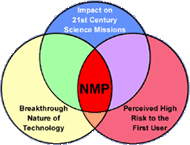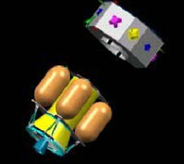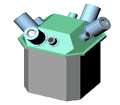 |
From technology development
to technology use.
|
NASA's New Millennium Program (NMP) provides a critical bridge for researchers and scientists to check out high-risk technologies and concepts in space, an environment that can't be replicated in Earth laboratories. The Program aids in the development of new technologies and capabilities needed to meet NASA's Earth and space science program goals. Once the technology is developed, flight validation reduces the risks to first-time users. The NMP process enables rapid technology infusion into future missions.
Flight Testing Enhanced Technologies
 |
ESA's LISA Pathfinder and propulsion stage.
|
Following NMP's objectives, Space Technology 7 (ST7) will flight test the Disturbance Reduction System (DRS), demonstrating that a solid body can float freely in space completely undisturbed. The DRS enhanced position measurement and control technologies will then be applied to follow-on missions well into the 21st century. The Laser Interferometer Space Antenna (LISA), a gravitational-wave observatory, will be the first of such missions.
For NMP validation, and in preparation for the LISA mission, the DRS will fly on the European Space Agency's LISA Pathfinder spacecraft. Onboard, the ST7 DRS will undergo rigorous in-space testing for a period of 90 days. During this time, the DRS primary goals are to validate a) performance of improved sensor technology (provided by ESA) and b) nanometer spacecraft position control——to an accuracy of a few millionths of a millimeter. ST7's MicroNewton thrusters are key to this precise level of position control.
What is the DRS?
The Disturbance Reduction System uses the sensor information supplied by the LISA Technology Package (LTP), which is part of ESA's LISA Pathfinder spacecraft. The LPT is based on the concept of freely floating test masses contained within a spacecraft that shields the test masses from external forces. Ideally, the test masses will follow a trajectory determined only by the local gravitational field. The spacecraft position must be continuously adjusted to stay centered about the test masses. In this way, the spacecraft essentially flies in formation with the test masses. The ST7 DRS, then, consists of clusters of micronewton thrusters and drag-free control software residing on a dedicated computer. The software uses sensor information from the LTP to control the thrusters as actuators, and thus keep the test masses totally isolated from external forces.
 |
Micronewton thrusters.
|
Changes in the capacitive-position signals (see information on LISA Technology Package) starts software that fires the micronewton thrusters. In this way, spacecraft position is controlled. The thrusters, mounted in clusters at two points on the spacecraft perimeter, will counteract both external and internal pressures on the test masses. While in orbit, the strongest external force on the ST7 spacecraft will be from sunlight, which will be equal to one-hundredth the weight of a postage stamp!
Internal disturbances such as gravity from the spacecraft itself will be countered by the thrusters as well. This is achieved by "drag-free" control of spacecraft position, using the micronewton thrusters and the capacitive measurement method.